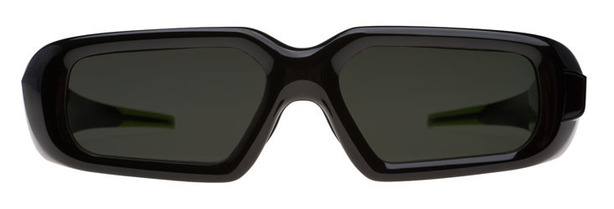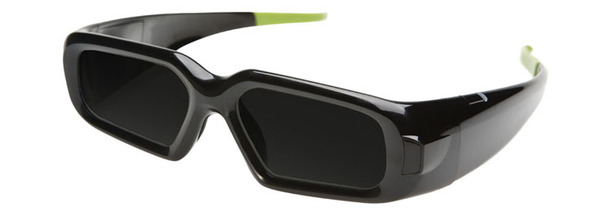
Comfort and Style
Before we get stuck into gaming performance proper, there’s one thing that we really need to emphasise to both Nvidia and our regular readers; the 3DVision bespectacles (Shutter-glasses, actually – Ed) are not your average pair of glasses in any regard.The fact that they let play games in 3D and feature all sorts of fancy quasi-futuristic and semi-retro technology aside, the 3DVision specs are just generally a bit clunky. They are more cumbersome and weighty than anything you might find down at Specsavers – arguably where Nvidia should have gone before they released the product!
Still, the green graphics giant has done its best it has to be said and the stiff, heavy frames aren’t as painful or nosebreaking as they might otherwise have been. They don’t curl around the back of your ears for example, which means that if you wear regular glasses in your day-to-day life then you can mostly wear these on top for a while before your head gets sore.
We really like that Nvidia has done it’s best to make the most of the unfortunately bulky frames too – a single charge of the shutter glasses will give you 40 hours of wireless 3D gaming before you have to recharge it.
Things like that almost balance out the fact that you’ll probably need to get a new 1200hz monitor in order to actually use the tech. It’s that unfortunate requirement for a specific type of monitor, which is a sad limitation of the technology, which really cripples the 3D vision…but we’ll get to that later.
More of an issue with the 3DVision shutter-glasses is the fact that they only really work best in certain conditions. Ideally you want to play your games with all nearby lights turned off and no extra monitors on. If you’ve got an illuminated keyboard or mouse then you’ll want to turn them off too.
The reason for this required darkness is that the light sources we take for granted work by pulsing light faster than the human eye can see, to give an impression of constant light. Your monitor might look like it’s beaming constantly right now, but it’s actually refreshing and flashing 60 times a second. The same is true for lamps, backlit keyboards and fluorescent lights. Sunlight thankfully isn’t a problem.
If the 3DVision tech used those old fashioned red and blue glasses then that wouldn’t be a problem, but they don’t. Instead, as Harry’s explained, the shutterglasses are flashing too – but they do it at a different frequency. Wearing the 3DVision gear in a well lit area will make the world look like it’s trapped in a seventies disco, strobing you into a headache in record time.
It’s a sad fact that eyestrain is a bit of an issue with the 3DVision too, though only at first and not as bad as you might expect. When you first sit down to play a new game it can take a fair bit of tinkering to get the depth settings right, especially if the game has a prominent HUD as these tend to hover above the action a bit nauseatingly.
It’s here that the USB-powered IR controller comes into play as, by using this and a set of keyboard shortcuts, you can easily tweak the depth and convergence settings for your games to eliminate any problems you might be having.
All in all then, despite being a woefully chunky and unstylish piece of headwear, the Nvdia 3DVision shutterglasses are a remarkably useable bit of kit. The software on the front-end is so streamlined it could sink submarines and it blends seamlessly into existing Nvidia driver software to create a immediately accessible and straight-forward addition to your gaming experience.

MSI MPG Velox 100R Chassis Review
October 14 2021 | 15:04










Want to comment? Please log in.